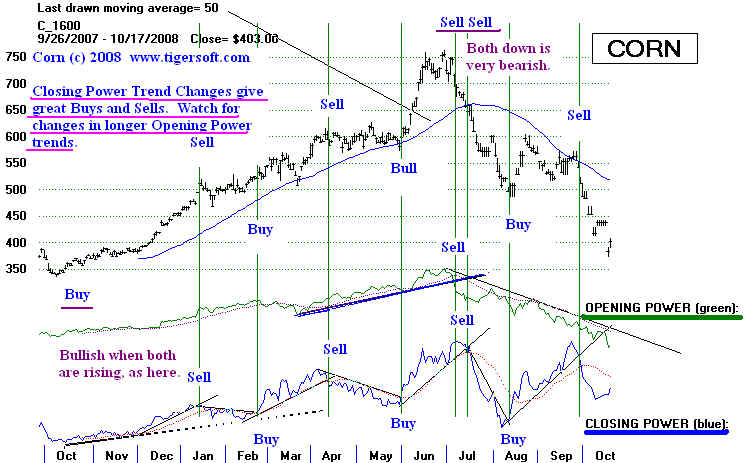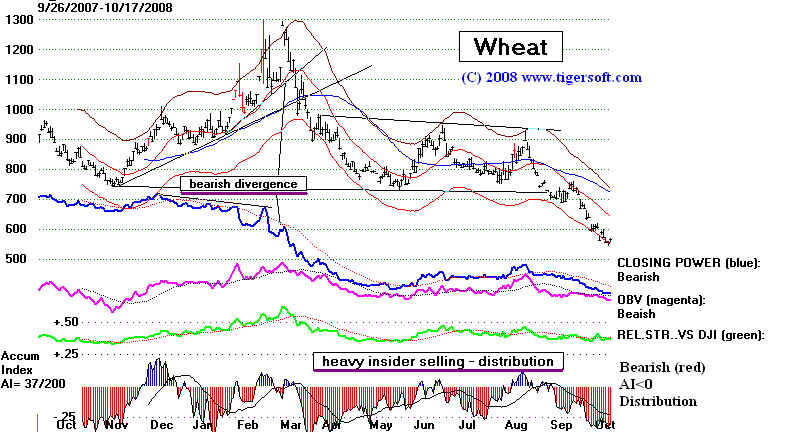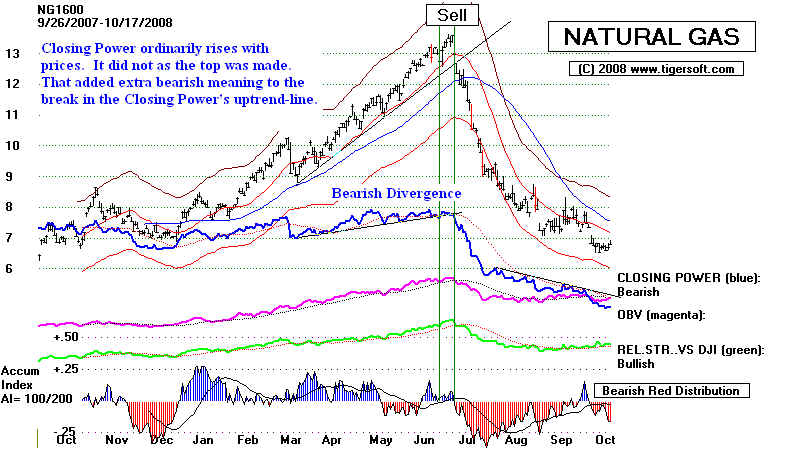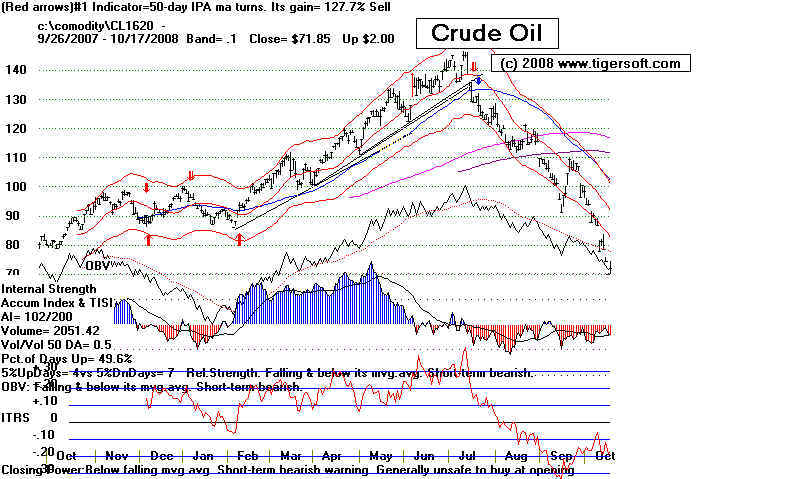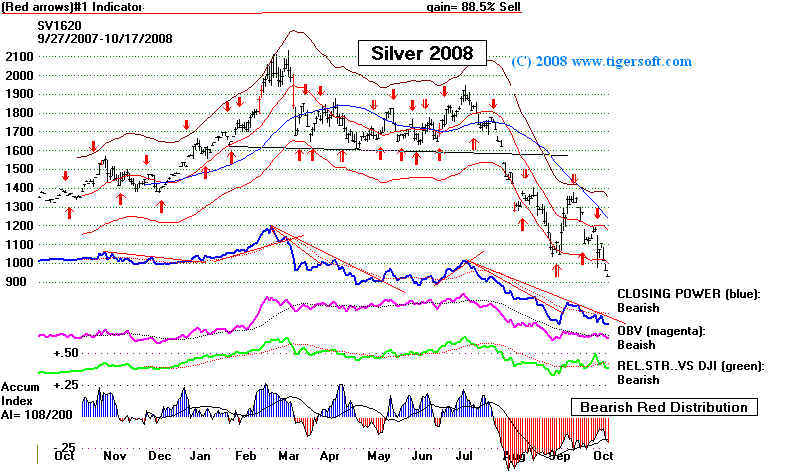The Rise and Fall of Commodities' Hedge Funds
Pump and Dump
Oil, Silver, Gold, Food Commodities -
It's All The Same.
COMMODITY EDGE FUNDS ARE DESPERATELY TRYING TO RAISE MONEY NOW.
THEY MUST SELL EVERYTHING.
by William Schmidt, Ph.D.
Author of TigerSoft and Peerless Stock Market Timing:
1915-2008 and Nightly Hotline
Wall Street Is Not Trusted. But Who Has Confidence in Washington?
It is hard to imagine a set of policies that would more
effectively
destroy long-term confidence in financial markets than the
one Bush, anti-regulation ideologues and Wall Street hipsters have
foisted upon the American people since 2000. Speculative excess,
unbridled greed, unchecked de-regulation, rampant cronyism and
greed lay behind the Crash of 1929. We are headed there again,
unless an abrupt U-Turn is made by the nation's policy makers.
The administration's obsessive devotion to the principles of laissez-faire
has now been matched by massive bailouts, totaling a trillion dollars,
for Wall Street bankers. No wonder wealth is more concentrated
than at any time since 1928.
Will an Obama or a McCain Administration bring a U-Turn? Can
A depression be avoided? Despite all their talk about more regulation,
the bailouts for Wall Street have the approval of Democrats Obama,
Nancy Pelosi and Harry Reid and Robert Rubin of CitiGroup.
An ugly truth is emerging: a class war against Main Street,
the middle class and the working class is now being waged by both
political parties' elites. With real wages declining for workers for
30 years, credit supremely tight, and the costs of health insurance and
education rocketing up, how can a long recession that amounts to an
economic depression be avoided?
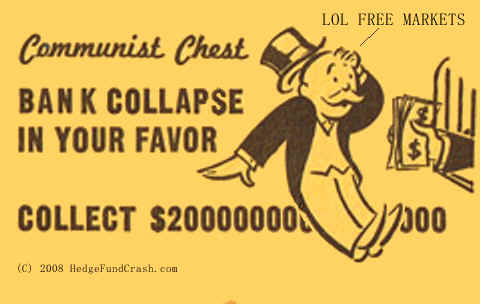
Bush has robbed the US Treasury dry. He has given billions,
even trillions, to the Wall Street bankers, private military contractors
and oil company executives who put him in office. Incredibly,
one
twelth of the nation's entire annual GDP (all the nation's goods and services),
has now been ear-marked to save American bankers from the
consequences of their own mistakes and greed. Small wonder
confidence has been so badly shaken.
For his final insult, Bush has now turned the job of fixing the economy
to the very Goldman Sachs thief (Treasury Secretary Paulson - with
a personal net worth of $700 million) who lobbied from 2000 to 2004 for
banking and financial markets' de-regulation and authority for hedge funds
to use much greater leverage. This is EXACTLY what caused the very mess
we are now in. How can confidence be restored by Paulson?
Hedge funds are not regulated. Hedge fund managers are allowed
to take huge chunks of hedge fund profits, but never be liable in any
way for the losses they might create for their clients. In this situation,
of course, they took dangerous risks and used too much leverage.
But that's just part of the story. Commercial banks were
allowed
to sell home mortgages to others once they were allowed to become
investment bankers in 2000. They hyped, obfuscated, packaged and
sold the home mortgages they made and used the proceeds to permit
still more unsafe loans. Lending standards became a joke. They were
nearly unimportant. Someone else could always be counted on to
buy the neatly packaged mortgages.
Another element in the picture was the freedom of hedge funds to
sell short without bothering to even borrow stock, do so on down-ticks
and to not have to report their positions, as they would have been obliged
to if they were buying shares. In this unregulated environment, they
were seldom accountable. They could mercilessly try to drive a
company's stock down, down, down. They could spread false rumors
about the company they were shorting with very little chance that they
would be caught and prosecuted. The SEC still refused to ban short
sales on down-ticks. All in the name of a "free market". The truth
is probably much more sinister. SEC Chairman Cox has probably
received some special considerations from the hedge funds he refuses
to limit. This we cannot know. The SEC does not investigate itself..
In all these way, the anti-regulation zealots have created an
investment climate that could not have been better designed to
create a financial disaster, had that been their intention all along.
Paulson has long been dead-set against trying to cool the bubble in
commodities, just as Greenspan had steadily opposed trying to
contain the housing bubble. "Wall Street profits should not be
contained." Like Greenspan, an earlier backer of the bank
deregulation,
Paulson consistently maintained that commodity and stock prices
should be left to themselves. "There was no need for the government
to intervene in financial markets", he stated time after time. The
economic outlook was rosy as ever. There would be no recession.
As a result, he did not lift a finger to prevent the bankruptcy of
Lehman Brothers in September 2008. When Freddie Mac and
Fannie Mae failed, the US government nationalized them, because
these two entities owned $5.5 trillion in home mortgages and
the US Government has long implicitly guaranteed them. Paulson
changed his laissez-faire approach with the collapse of AIG. This
insurance giant was closely linked to hedge funds. If they started
selling their assets, even more hedge funds might fail. So, he stated
"AIG was too big to fail" and the US bought an 80% interest in it.
The financial debacle among hedge funds we are seeing now
has had far-reaching ripple effects. While hedge funds were set
up exclusively for very wealthy and experienced investors, it is
average investors who typically are now suffering the bulk of the
financial distress caused by the failures of so many hedge funds.
Financial stocks and commodities' stocks make up a heavy
percentage of the SP-500 and DJI-30, which so many mutual funds and
ETFs have endeavored to match. For years, small investors have been
told to simply "buy and hold" these investments. "Never
sell until, you
retire." "The market cannot be timed". This they were told by the
"experts", who it turns out were only the unthinking salesmen of the
very firms who pushed for de-regulation and the prime beneficiaries
of the unregulated boom. Conveniently, they swept out of sight
the
rocky, roller-coaster years, 1929-1941 and 1966-1982. Small
investors were no to quickly buy and sell, like the hedge funds
did. What hypocrisy! It seems that each generation forgets the lesson
that markets are highly cyclical.
The Dangers of Excessive Leverage
Billion dollar hedge funds have used their leverage to buy hundreds
of billion dollars' worth of commodities and securities. Even so, the prices of
commodities like Wheat, Corn, Crude Oil, Natural Gas and Silver collapsed
in the Summer of 2008, even as the hedge fund chiefs doubled down their bets,
a tactic they had often used successfully in the past.
The
Dynamics of "De-Leveraging"
A wider financial disaster was now hiding in the shadows. When
the hedge funds' efforts to prop up prices on the decline failed in July
and August, it was mostly because prices were just too high and
beyond the reach of world consumers. When they double-downed in
September,
they were blind-sided by the take-overs of Freddie Mac
and
Fannie Mae, the bankruptcies of Lehman Brothers and Washington
Mutual,
the government takeover of bankrupt AIG and the near-bankruptcies
of
Merrill Lynch and Morgan Stanley.
When
there was no rebound, these hedge funds started to panic.
Prices
fell disastrously. Because of the over-leveraging, margin and
new
collateral calls came quickly. Word leaked out that big funds were
selling
big positions under duress. The polite term was "de-leveraging".
Rumors spread and stock brokers front-ran the hedge funds' Sell orders.
Other
"rogue" hedge funds smelled blood. They used their extra leverage
to sell short the very stocks and commodities that the troubled funds
had
to unload. And now they could sell on down-ticks, thanks to the SEC
and Chairman Cox. As prices dropped, good stocks had to be sold
along with the bad. Nothing could escape. Other over-leveraged
hedge
funds were caught up by the same dynamics. As losses mounted,
articles started appearing. This made investors want out. Redemptions
rose. Expectations of rising redemptions rose. More stocks had to be
sold.
Seeing prices fall much more quickly than normally, regular buyers
withdrew their buy orders and chose to wait for the decline to stop. This
just made matters worse. Such were and are the dynamics of the 2008
financial panic.
Collapsing Hedge Funds and
Falling Commodity Prices
Create Short Term Weakness in Gold
"Many hedge fund managers are under severe
pressure to liquidate positions as
banks request more collateral to back funds' borrowing. Many hedge funds, including
some of the largest, have gone to the wall in recent months and Credit Suisse estimates
that 30% of roughly 8,000 hedge funds will close over the next few years. Wealthy
investors are turning their backs on high risk hedge funds as there is a reevaluation
of the sensibility of massive leverage and banks are no longer willing to fund the hedge
funds' speculations." 10/17/2008 Source.
George
Soros wrote in January 2008 that the "era of
superleverage" had
ended. Ihe was six months' premature. He was right in saying there has been a
"systemic failure" and
there was then no financial sherif on watch.
NYTimes - 1/23/2008 comment to article on Soros:
"The derviatives market, incluing the credit swap
market, is over
$750 Trillion (that’s with a “T”). Global GDP is estimated at $50 Trillion.
It doesn’t take a “systemic failure” to cause a nightmare. A failure of
less
than 7% of derivatives contracts wipes out global GDP. The fact that derivatives
are the most highly leveraged asset class on the planet (up to 100 to 1) means
that the 7% failure could be brought about by only a fraction of real, underlying
asset decline. " Mark S
- 1/23/2008 comment
"We need new words in the English language to
express the unbelievable
corruption of the US government in its allowance of the banking and Wall
Street crowd to take this country to the edge of financial disaster due to greed.
Now how do we justify the government bailing out these greedmeisters with
public tax money? Bush will go down in history as the most corrupt and
incompetent president ever. Ron
A Systemic Failure
In the financial world, you would be hard pressed to design a
system better able to produce an extreme cycle of binge and purge,
boom and bust, pump and dump. This was the system that the Bush
Administration has set up after 2000, all in the name of "free
markets"
and "private enterprise". In light of the bailouts, his hypocrisy would
be humorous, if it were not so tragic. He has destroyed much more
enterprise and labor than he ever created. We are far less safe.
And his markets are anything but "free".
It's easy to see in retrospect what produced the
financial panic
of 2008. But, for me, it was the TigerSoft charts showing heavy insider
selling that was the first alert. When you see such very red
"Distribution"
and a pattern of sell-offs after a string of strong openings, you should
be put on high alert.
I don't pretend to know more than I really do. But elsewhere
I have warned frequently about the housing bubble and how banks
sold bundled mortgages that they knew, but did not care, were not
soundly financed.
8/1/2005 "Housing Bubble Trouble"
http://tigersoft.com/Housing%20Bubble/index.html
6/5/2006 "Home Building Stocks Are Particularly Weak"
http://www.tigersoft.com/What'sNew/index.html
3/10/2007 "Insider Selling in Mortgage Lenders"
http://www.tigersoft.com/Housing%20Bubble/Second%20Leg%20Down.htm
5/14/2007 "Is
Washington Mutual the Next Bear Stearns or Northern Rock?"
http://www.tigersoftware.com/TigerBlogs/May-14-2008/index.html
6/14/2007 "Absolutely, The 1929 Crash Could Happen Again."
http://www.tigersoft.com/Tiger-Blogs/6-19-2007/index.htm
6/4/2008 "Far from Over, The Credit Crunch Is Worsening:"
http://www.tigersoftware.com/TigerBlogs/6-4-2008/index.html
7/16/2008 "Investing in A Perfect Storm"
http://www.tigersoftware.com/TigerBlogs/July-16-2008/index.html
Here I want to talk about billion dollar hedge funds using 200:1
leverage. Their callous, unbridled and selfish greed is
to blame. They
created the commodities' boom, apparently not caring one iota about:
(1) the deleterious effects on poor people around the world that
were starving for rice, wheat and corn;
(See - 4/19/2008 - TigerSoft
News Service - Hoarding, Food Riots, Starvation ...
2/26/2008 - Food Commodities Streak
Upwards.
2/22/2008 - Food Commodities Are
Going Hyperbolic
(2) that they were making consumers pay sky high gas prices,
which were sure to deprive consumers of so much buying power
that a recession would became a foregone conclusion;
4/20/2008 - "Yes",
People Are Bitter.
(3) that they would create an artificial bubble in commodities, not
unlike the Hunt Brothers' effort in 1979 and 1980 to corner the
market in silver, and this ould only end very badly and wipe out
the savings of millions, in its aftermath.
From 1979 to January 1980, the Hunt Brothers from Texas tried to
buy up all silver futures' contracts and corner the market. They would
have succeeded. But the commodities' exchange changed the rules
on them and limited the numbers of contracts that could be held
individually. The result was that they had to sell. Silver collapsed
75% in ten weeks, from $48/ounce in January to $11/ounce. Margin
calls drove prices, down, down, down after prices broke below
the neckline in the head and shoulders at 3100.
BOOM AND BUST
-------------------------------------------- Silver 1980
---------------------------------------------------
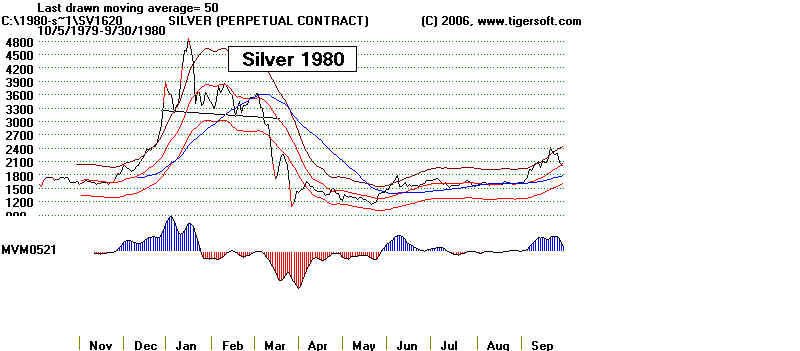
A generation later, in 2008, silver like many other
commodities is doing
the same thing, going down, down, down. Will it have to drop 75%
and fall below $5/ounce, as it did in 1980? In many ways, the commodities'
bubble of 2008 is much bigger than in 1980.
Tiger Crude Oil: Boom and Bust
Crude Oil broke its uptrtendline and its blue 50-day ma. while still above 130,
Red and Blue Sell signals flashed from TigerSoft. TigerSoft's Accumulation Index
was in negative territory. Our Opening and Closing Power Lines were both falling.
This is the bearish of combinations. The black 200-day ma is violated straight away.
Prices do not get back above it and are hit with renewed selling. Technical
conditions
do not get better. A 12-month low is made.
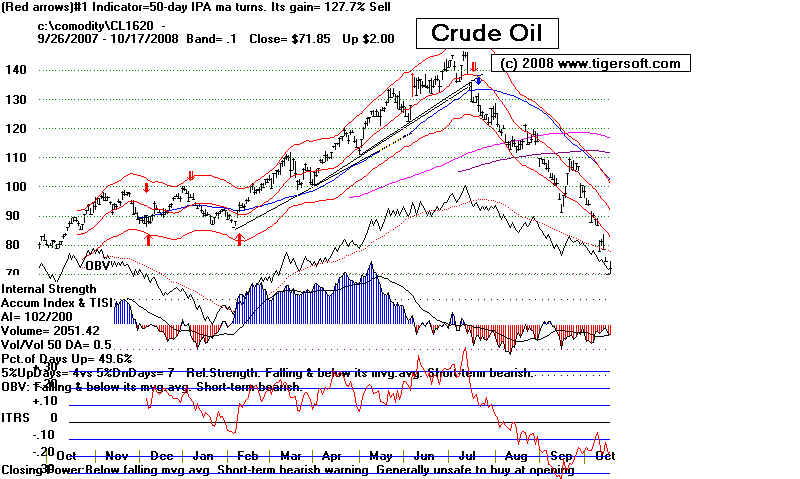

THERE's ALWAYS MORE THAN ONE COCKROACH
The collapse of one big firm endangers others. First, it was Bear Stearns,
then Morgan Stanley and Washington Mutual. Then Fannie Mae, Freddie
Mac and AIG had to be bought out by the US Government. It is not just
a matter of shattered confidence. It is also that these firms' holdings had to
be dumped on the market, making market valuations drop sharply for the
securities that they are selling. And that produces more margin calls and
under-capitalization notices by the FDIC. This produced yet another round
of selling. And so the cycle was self-perpetuating.
Seldom does only a single commodity crash. Others commodities
soon also drop, out of fear and out of necessity. Hedge funds and commodity
funds get margin calls and they must sell out their other positions. This puts
the same pressure on more and more firms investing in commodities. Below
you can see that 10 of the 19 commodities topped out in July 2008.
Commodity Fall 2007 Low
Earlier 2008 Peak Now -
10/17/2008
---------------------------------------------------------------------------------------------------------
Corn (C)
345.
754.75 (6/27/2008)
403.
Coffee (CC1600) 118.90
164.60 (2/29/2008)
115.60
Crude Oil
80
145.10 (7/14/2008)
71.85
Corn
2000
3360 (7/1/2008)
2122.
Copper
287.30
407.75 (7/2/2008)
219.45
Gold
72
99.22
77.21
Heating Oil 220
407.66 (7/11/2008)
213.29
exception Lead
80
98.00 (2/12/2008) hit 62.25 87.48
Live Cattle
94
103.33 (7/1/2008)
91.05
Live Hogs
52
78.60 (7/25/2008)
56.30
Lumber
225
270.10 (8/20/2008) 199.
Natural Gas
7
13.39 (7/2/2008)
6.79 example
Oats
261
455 (7/3/2008) 282
exception Orange
Juice 130
128.85 (7/1/2008)
83.55
Platinum
13800
2276.`10 (3/5/2008) 872.50
Silver
1325
2068.50 (3/5/2008) 931
Soybeans
920
1658 (7/3/2008)
894.
Sugar
9.70
14.13 (8/7/2008)
11.58
Wheat
752.50
1257 (3/12/2008) 566.25
Tiger Index of 19 Commodities and Metals
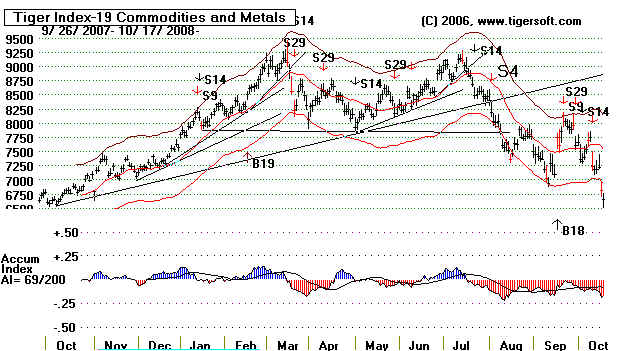
FREEDOM FOR THE PIKE IS DEATH FOR THE MINNOWS
By creating stock market bubbles, highly unequal and
unrestrained power
threatens the security, liberty and livelihood of smaller investors and all American
workers. Taliban-like, hypocritical devotion to a free market is a dagger
pointed
at the heart of American democracy. All booms seen to foster an unsavory
assortment of hipsters, promoters, parasites, swindlers and cheaters. They
just be regulated, or the results are tragic for millions that don't even own any
stocks.
WHAT's A HEDGE FUND?
Hedge funds are private and unregulated pools of capital
that invest across all markets. Hedge funds
often do not hedge. They are not more conservative as the word "hedging"
might suggest. Most often, they
use complex, aggressive and risky strategies, in seeking higher returns for their wealthy
backers.
The most important commonality among hedge funds is how managers are compensated.
Typically
this involves management fees of 1-2% on assets and incentive fees of 20% of all profits.
This is in
striking contrast to more traditional investment managers, who do not receive a
percentage of profits.
These compensation structures encourage greedy, risk-taking behavior that normally
involves leverage
to generate sufficient returns to justify the enormous management and incentive fees.
A HEDGE FUND NEARLY CRASHED THE MARKET IN 1998
US Federal Reserve Board chairman Alan Greenspan
acknowledged in 1998 that the collapse of the
hedge fund Long-Term Capital Management last month could have brought a huge crisis on
Wall Street and global financial markets. As it was the DJI merely fell 20%
in 3 months.
Testifying before the US House of Representatives Banking Committee, Greenspan said the
$3.6 billion bailout organized by the Federal Reserve Bank of New York was necessary
because
of the fragility of international markets. :"Had the failure of LTCM triggered the seizing up of
markets, substantial damage could have been inflicted on many market participants,
including
some not directly involved with the firm, and could have potentially impaired the
economies of
many nations, including our own." Greenspan warned that had LTCM been liquidated through
a "fire sale" of its assets this would have resulted in a "severe drying up
of market liquidity"--in other
words, a credit crunch that could have rapidly spread, setting the stage for further
collapses.
WHAT HAPPENS WHEN MARKETS BECOME ABNORMAL?
Greenspan's testimony pointed to the the strong possibility
of future financial collapses. He said
LTCM had based its transactions on mathematical models that sought to profit from
differences
between the current price of financial assets and their historical trend. By
investing vast amounts
of capital, borrowed from the banks and other financial institutions, the fund was able to
make
substantial profits just so long as "normal" conditions applied and the price of
financial assets
returned to levels predicted by their historical models. But markets change
In the case of LTCM, it assumed that short-term interest rates would tend to rise in the
market.
However, in the aftermath of the Russian ruble collapse and default in August 1998, there
was
a rush of capital into US Treasury bonds--the so-called "flight to
quality"--that pushed up prices
and sent short-term interest rates to their lowest levels in almost three decades. As a
consequence
LTCM suffered what Greenspan termed "stunning losses," and was forced to
liquidate the majority
of its capital base.
HEDGE FUND PROLIFERATION AND 100:1 LEVERAGE IN THE 1990s
Hedge finds using predictive models based on normal market behavior have
proliferated. A New
York Times estimated that their number has doubled from 1990 to the end of 1997,
and then
stood at 4500, while investors' capital in them has increased six-fold to $300 billion. As
large as
these sums are, they are only partially indicative of the potential impact of hedge funds
on the
global financial system. In the case of LTCM, for example, the $2.2 billion supplied by
investors
was used as collateral to buy $125 billion in securities that were then used, in turn, as
collateral for
derivatives transactions worth $1.25 trillion.
Commodity hedge funds now oversee about $55 billion in 2008, up from
$30 billion in 2007 and
$14 billion in 2006, according to Cole Partners Asset Management in Chicago, an investor
in these
funds.
California's public employees'
pension fund, the world's largest, made its first investment of $1.1 billion
into oil and other commodities early 2007. Other pension funds
rushed to get in on the action as
the prices of oil, precious metals, corn, uranium and other vital goods rose in early 2008
to record highs. Montgomery County officials shifted 5 percent of their $2.7 billion pension
fund away from stocks and into commodities in 2008.
Commodity markets are not geared to have
big funds sitting on long term positions of thousands
of commodity contracts for long periods for foods and so on. http://www.brownfieldnetwork.com/
EXAMPLES OF FAILED COMMODITY HEDGE FUNDS
Ospraie was the world's biggest commodity-focused hedge fund,
with
$7 billion under management. It
failed in early September. Ospraie sent a letter to
investors saying it was closing its nearly $3 billion flagship fund after a 27% loss in
August
left it down over 37% for 2008. According to SEC filings, Ospraie
had large positions in
Alcoa, Arch Coal, NRG Energy, and XTO Energy, which suffered
disproportionate losses
this week, after the fund's problems were publicized Osparie's collapse settled the fate
of Lehman Brothers, which owned 20% of it.
What
were the main reasons for the failure by a huge hedge fund, like Ospraie
that had $7 billion under
management? When commodities dropped they doubled their bet, hoping for a
recovery as before.
But it didn't. They weren't like individual investors. They were using
leverage of 150-200 to 1. That
means they were committing $450-$600 billion. They suffered from
"front-running" by their agents,
brokers putting in their sell orders. .For example, oil's steep drop on Aug. 22 may have
been related
to Ospraie's efforts to raise capital ahead of Tuesday's letter, where the fund said it
plans to disperse
40% of its assets to investors by Sept. 30. When prices kept falling all that
leverage worked against
them very quickly. And they had to sell even faster. Other commodity hedge funds made a
similar
mistake with the same bad result. They, too, got margin calls because of the falling
prices.
In commodities, speculators can buy silver or oil futures with only 7% down.
Sound familiar?
Highland
Capital Management LP plans to close its flagship Highland Crusader
Fund and the
Highland Credit Strategies Fund after losses on high-yield, high-risk loans, and other
types of debt.
Highland will end up with two funds in the next three years with more than $1.5 billion of
assets.
Citadel
Investment Group LLC, one of the world's largest hedge funds with about $18
billion
of assets, told Reuters that September 2008 was the worst month in its history. Its
main fund,
the $10-billion Kensington Global Strategies, is down approximately 22 percent for the
year.
Rumors are circulating Atticus Capital is liquidating positions, although
executives at the $13 billion
hedge fund deny that's the case, The WSJ reports.
$386 million Merchant Commodity Fund, run out of Singapore.
MotherRock, a $400 million fund run by the former president of the New
York ercantile Exchange,
Robert Collins, said in August that it was closing.
Amaranth Advisors, which collapsed after it took a $6.5 billion loss on
bad natural gas wagers.
Sentinel
Hedge Fund imploded in August 2007. A list of its creditors shows how
wide the
ripple effect is.
Even
c. |
 TigerSoft
News Service
10/19/2008
TigerSoft
News Service
10/19/2008
